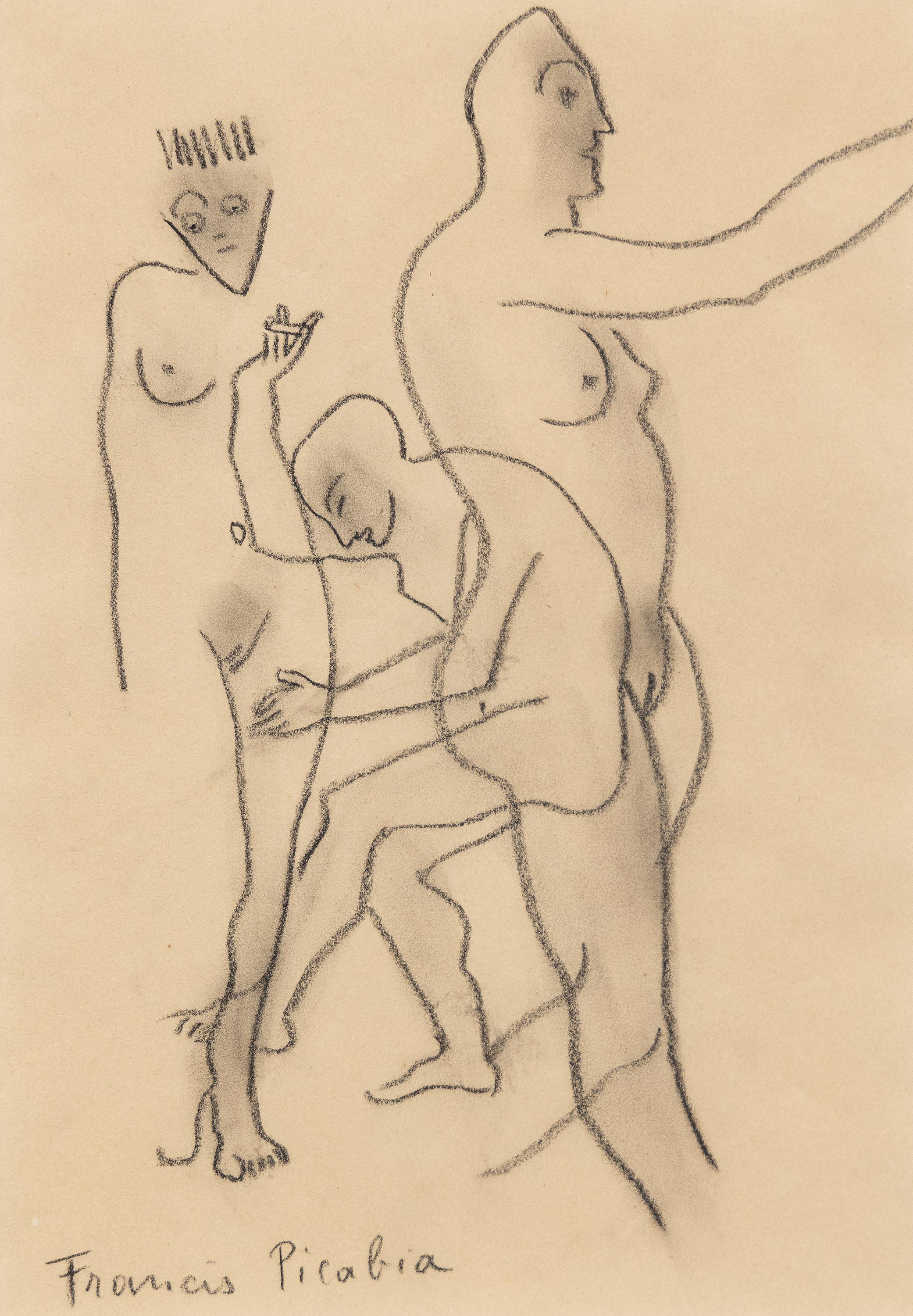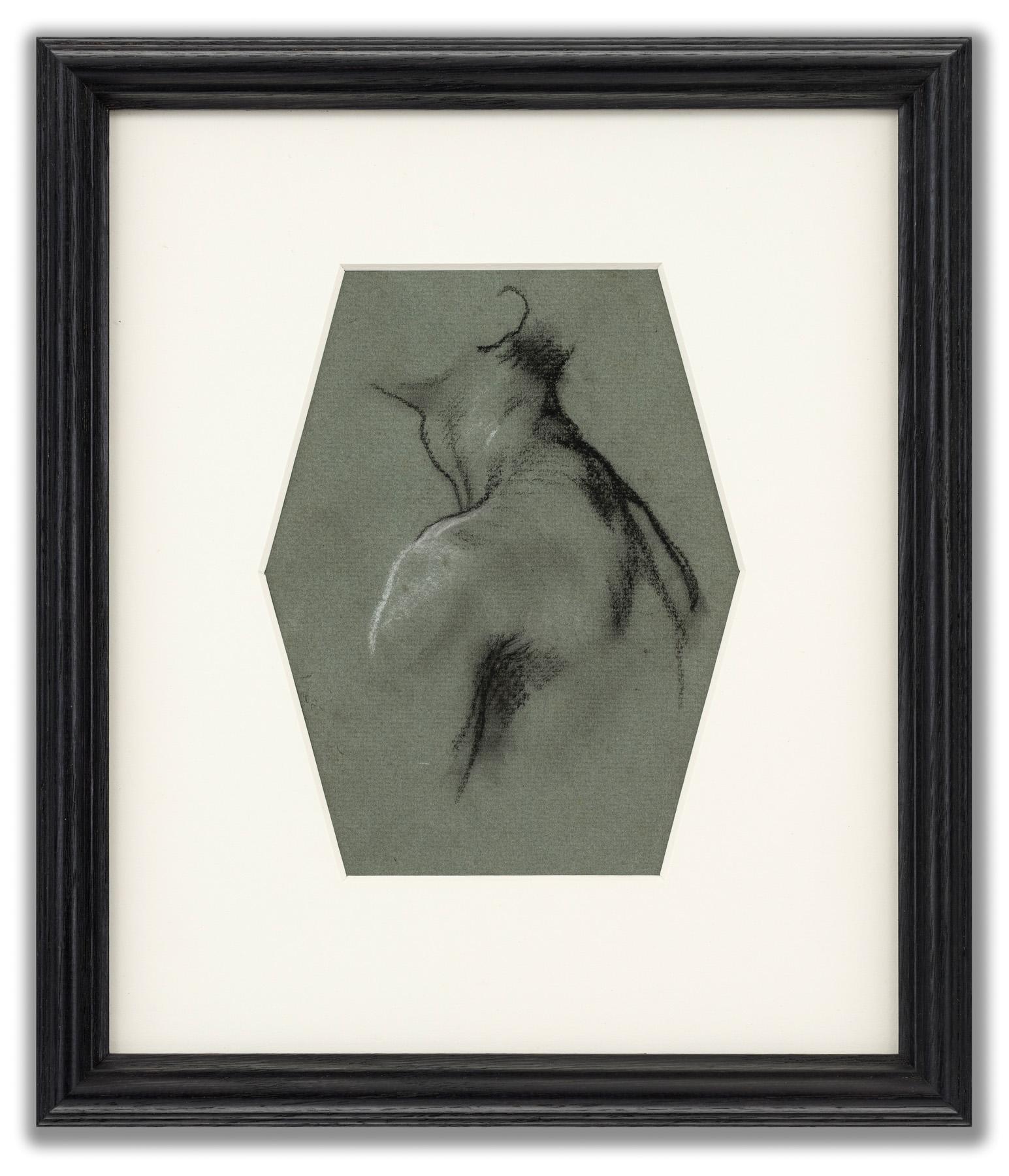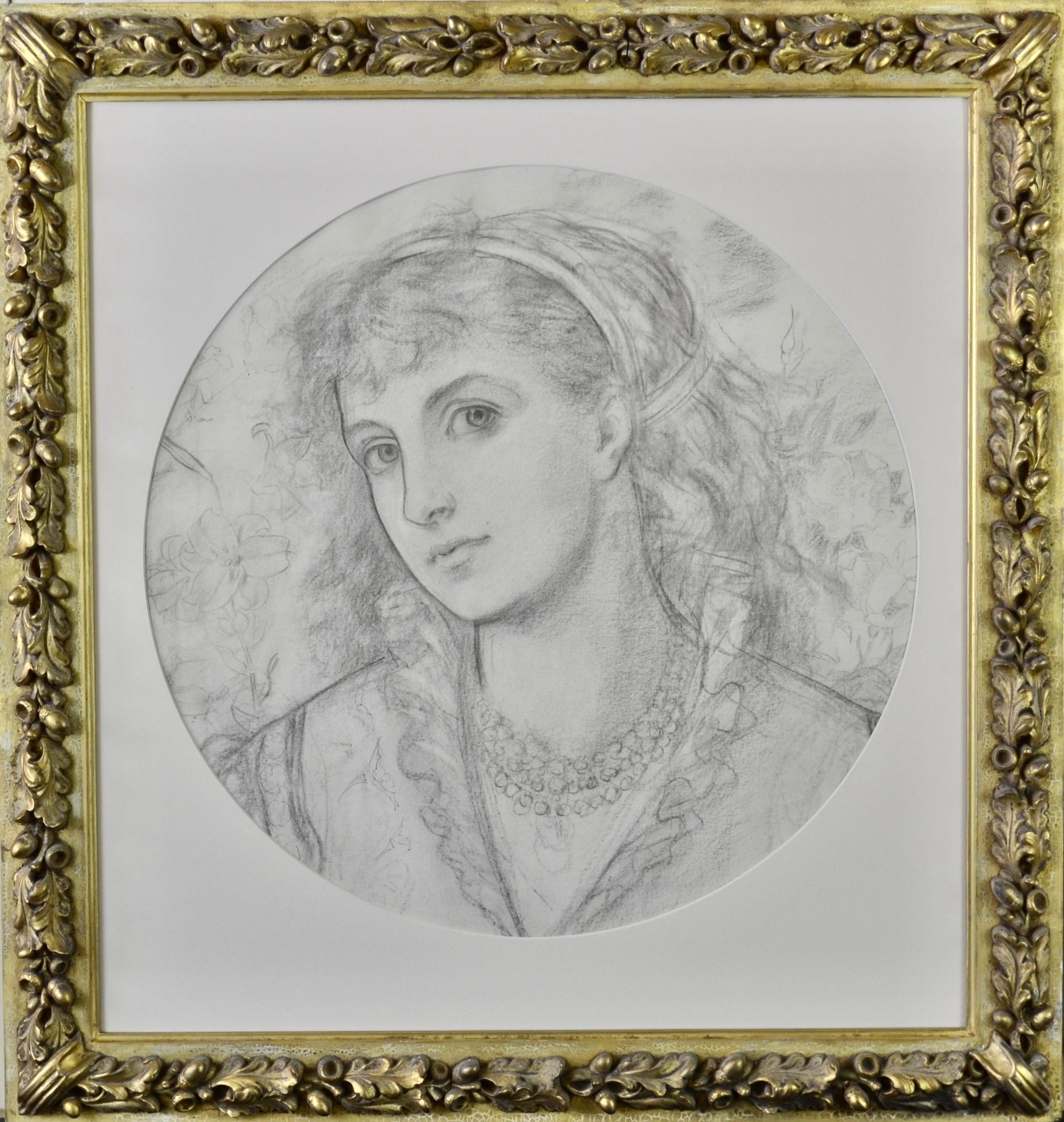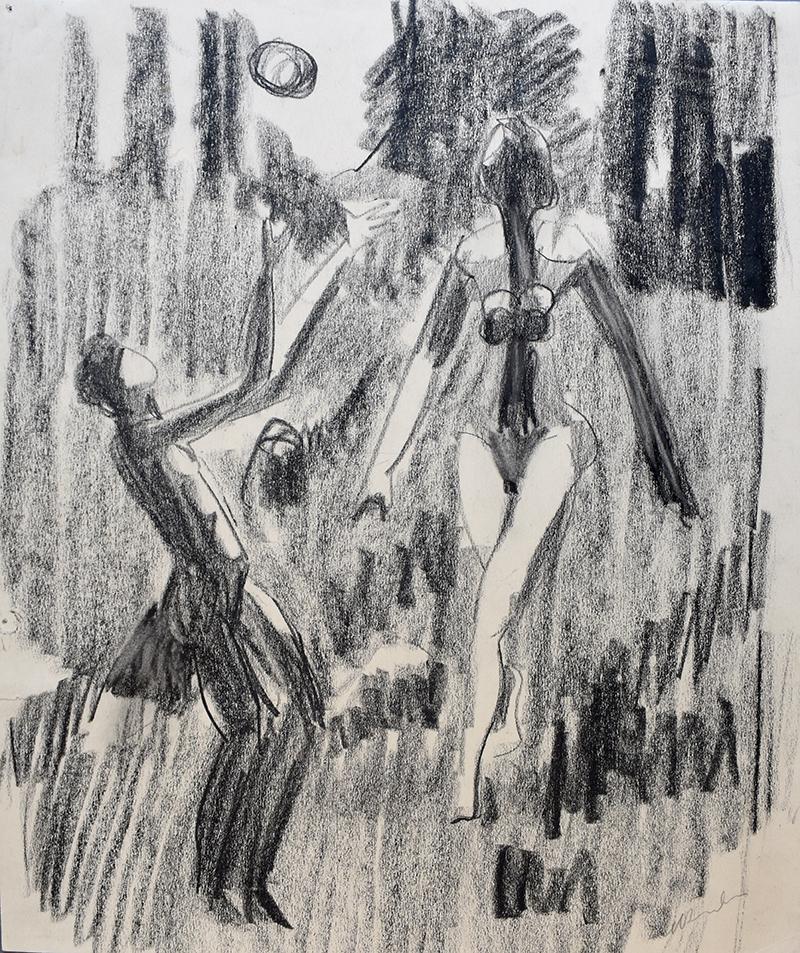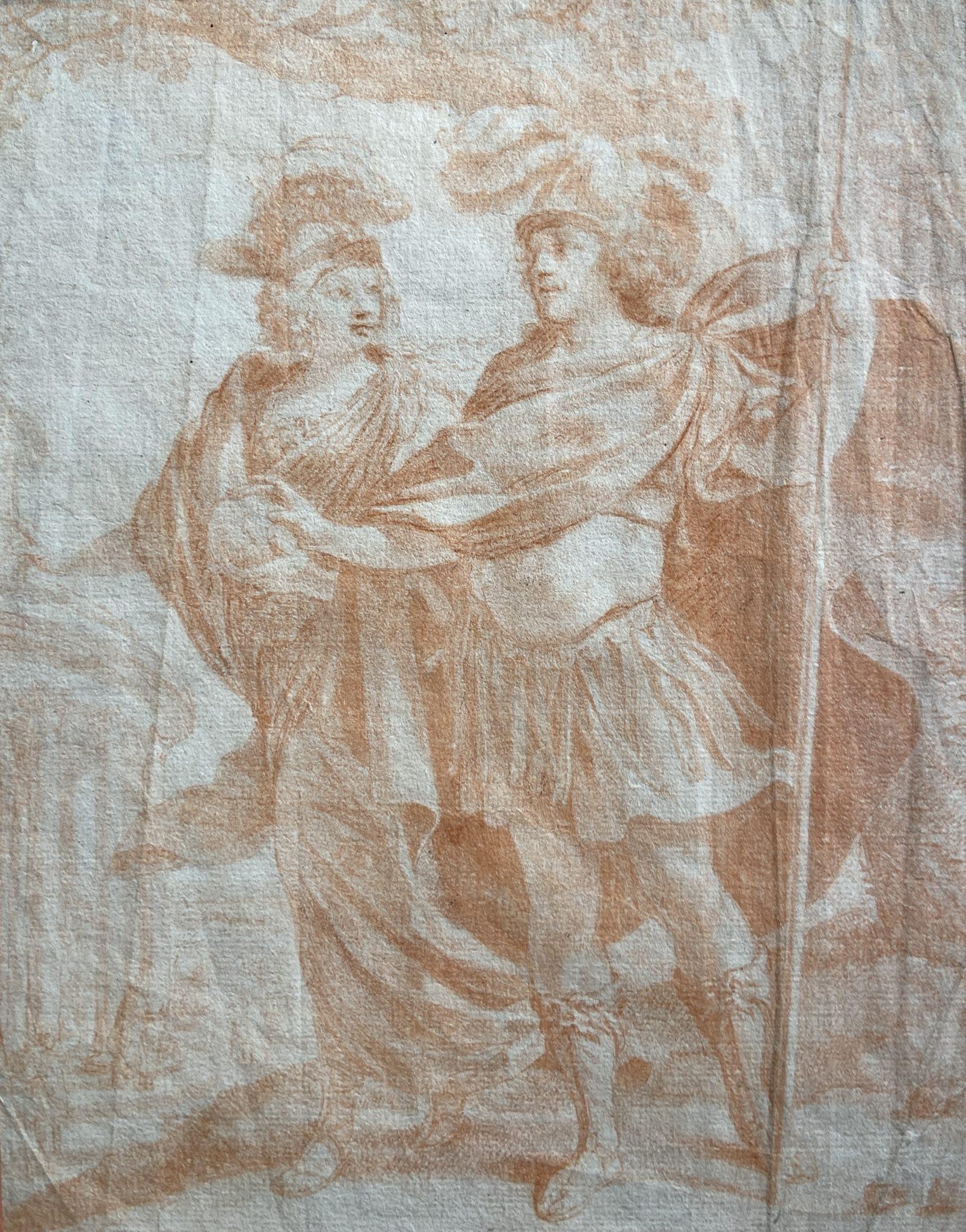Items Similar to Allegory of Chastity, a drawing attributed to G. Porta with great provenance
Want more images or videos?
Request additional images or videos from the seller
1 of 9
Allegory of Chastity, a drawing attributed to G. Porta with great provenance circa 1540
circa 1540
About the Item
This magnificent drawing from the Venetian Renaissance intrigues us in many ways. It depicts an allegorical composition whose meaning partly escapes us: a veiled figure seated on a stone bench (which we have identified as Chastity), seems to be turning away from a woman's bust beside her, below which are two rabbits, a traditional allegory of fertility, but also sometimes of lust.
This drawing, executed on blue paper, undoubtedly belongs to the Venetian Renaissance. The inscriptions on the back of the old mounting board indicate the various attributions considered by its last owner, the British painter and art historian Sir Lawrence Gowing. We have retained the attribution to Giuseppe Porta proposed by art historian John Arthur Gere as the most relevant.
We were incredibly fortunate to find a hexagonal frame of a very similar format for this drawing, the upper corners of which were formerly cut (irregularly). This 17th-century Dutch frame comes from an aristocratic collection in Lombardy, and creates a kind of fascinating chase around this Venetian drawing, which arrived in England (or in Holland, the native country of Sir Peter Lely, its first known owner) around the middle of the 17th century...
1. Giuseppe Porta, an artistic itinerary from Rome to Venice
Born in Tuscany, near Lucca, Giuseppe Porta began his apprenticeship in Rome around 1535 with another Florentine, Francesco Salviati, whose name he adopted in 1551. He accompanied his master to Venice in 1539 to help him decorate the Grimani Palace, and remained in Venice when Salviati left for Rome.
In Venice, he took up wood engraving and helped illustrate books. This engraving activity is one reason leading us to attribute our drawing to this artist, as the way in which the shadows are marked by parallel, sometimes crossed, strokes is very typical of the technique of a painter-engraver.
After spending time in Florence (where he met Vasari) and Bologna, he settled in Padua between 1541 and 1552, where he completed the cycle of the life of Saint John the Baptist in the Palazzo Selvatico. On his return to Venice, he worked alongside the leading Venetian artists of his time on the major decoration projects for the Doge's Palace and the Marciana Library.
2. Related artworks
The main figure in this allegory may have been inspired (with variations in the position of the arms and legs) by the Virgin Mary depicted in by Giovanni Battista Franco’s (1510 - 1565) print entitled "The Holy Family with Saint John the Baptist", a preparatory drawing of which (circa 1535) is now in the Bibliothèque Nationale de France (last photo in the gallery).
This proximity may explain the former attribution of this drawing to Franco, which is no longer accepted today by the specialists we contacted. On the other hand, it is entirely plausible that Giuseppe Porta saw this drawing (or the print made from it) during his visit to the engraving workshops after his arrival in Venice in 1539.
It is interesting to compare this drawing with two others in the Musée du Louvre. The first, of a similar format (16.1 x 11.2 cm), depicts an allegory of Temperance and was also executed on blue paper; the second, from the Jabach collection, depicts the Virgin and Child and bears witness to the long-standing interest of European collectors in this artist's drawings.
3. A long line of prestigious English provenances
The first documented owner of this drawing was the English painter Sir Peter Lely (1618 - 1680), whose mark was affixed to the lower right of our drawing by Roger North, one of his executors (Lugt 2092).
Peter Lely, "Principal Painter" to Charles II, was a successful portrait painter and art collector of great renown. Before moving to England in the early 1640s, he was a member of St. Luke's Guild in Haarlem, where he trained with Frans Pieter de Grebber. Once in England, he continued to paint landscapes with small figures, before specializing in portraiture. With the restoration of the English monarchy in 1660, he became one of the legitimate candidates for the title of court painter, a position previously held by Anthony van Dyck. In the years that followed, and until his death, Lely held a virtual monopoly on fashionable court portraits.
We do not know when Lely began his collection, and it is possible that he was still living in Holland at the time. Lely is likely to have profited from the multiple sales of confiscated English royalist property organized in the 1650s. At the time of his death in November 1680, his collection of paintings comprised over 570 pieces: just over half were by him or his large studio, and the other half included works by Dutch and Flemish artists such as Rubens and Van Dyck, as well as Italian masters of the XVIe century such as Veronese, Tintoretto and the Bassanos, and a few works by French and Spanish masters.
Alongside his collection of paintings, Lely built up a remarkable collection of prints and drawings, which he considered 'the best in Europe'. As with his paintings, Lely's executors organized sales to clear his debts. No catalog of the 1688 and 1694 sales appears to have been printed, but the mark consisting of the letters P.L (separated by a dot) gives an idea of the variety and quality of the works on paper in this collection.
The sale of his collection of paintings and drawings took place after his death, at his former home in Covent Garden, in April 1688. The result of this sale was £6,000, which was used to cover part of his debts. A collection of drawings bearing the P.L mark reveals a significant number by Italian artists of the 16th century, including Parmigianino, Correggio, Raphael, Perino del Vaga and the brothers Frederigo and Taddeo Zuccaro. The mark appears on 17th century landscape and figure drawings by Annibale and Lodovico Caracci, as well as on a small number of drawings by Claude.
The inscription in brown ink on the reverse "Primaticcio 3.3" reveals the identity of the drawing's next owner: William Gibson (1644-1702), the painter and dealer in drawings who also worked in Sir Peter Lely's studio. It is likely that he bought this drawing (along with others), at Lely's 1688 sale, where it was presumably catalogued as Primaticcio.
The price indications, which according to Richardson Jr's annotations had been affixed for the use of Gibson's widow, were described by Richardson Sr as follows : "[...]we see the Master's name, written in his hand, with two figures, which marked the price he estimated for them. The second of these numbers was always 1, 2, 3 or 4, of which the number 1 meant a Chelin [shilling], the number 2, a Penny [half a crown or 2 ½ shillings], the number 3, a Crown or 5 shillings, the number 4, a Sterling Pound [20 shillings], and the first figure, which he put before it denoted the quantity. For example: 2.1, meant two Chelins; 1.2, one Penny; 3.3, three Crowns; 3.4, three Sterling Pounds, and 10.4, ten Sterling Pounds." This inscription gives us an idea of the high value (three Crowns) given to this design by William Gibson at the end of the 17th century...
The British Museum and the Royal Collection at Windsor hold the largest number of drawings from the Gibson collection. The British Museum has 32 and the Royal Collection at least 51. The latter probably has an even greater number, since many of the sheets in the collection are fully glued, and it is not always possible to check the verso, which may or may not validate the price tag. In the case of the British Museum, on the other hand, the code was sometimes found on the reverse of an old mount (inv. SL,5236.99 as School of Agostino Carracci) or on the reverse of an old lining now deposited (inv. 1952,0121.80 as Polidoro da Caravaggio).
The drawings that passed through Gibson's hands are almost all Italian, and most date from the 16th century. Finally, it is worth mentioning that many drawings from the Gibson collection have the top corners cut off (at least 14 leaves from the Royal Collection), like the one we are presenting here, which must have corresponded to a practice possibly representative of one or even several English collectors of the period.
As for the dispersal of Gibson's collection (or stock), we have already quoted Jonathan Richardson Jr. who states that after William Gibson's death, the Duke of Devonshire and Jonathan Richardson Sr. and Jr. were able to purchase many drawings directly from his widow. Note that there was also an after-death sale on March 9, 1704, held in his former home, "the lowermost Great House in the Arched-Row in Lincolns-Inn-Fields".
The third provenance plunges us into the world of twentieth-century English art historians: the last collector to own this drawing, Professor Sir Lawrence Gowing (1918 -1991), was first recognized as a portrait and landscape painter. Self-taught in art history, he went on to make a name for himself as an art educator, writer and, eventually, curator and museum administrator. He has been described as a leading member of the "English establishment".
An inscription on the backboard of the original mount evokes the scholarly atmosphere and curiosity that characterized his relationship with works of art:
Popham (from the grave)
Pouncey (after a rethink) and
Gere (upside down) now
agree that this drawing
is by Battista Franco
This inscription complements other attributions: Salviati (the oldest inscription at top right); Parmesan School; Giambattista Zelotti (RBH, an art historian whose initials we have not identified); Giuseppe Porta called Salviati (JAG, probably John Arthur Gere).
This latter attribution seems to us the most relevant, given the stylistic proximity of our drawing to other artworks by the artist. Also noteworthy is the use of blue paper (although now faded). The use of this paper had been discovered by Francesco Salviati during his visit to Venice around 1540 and his pupil Giuseppe Porta used it on many occasions, as shown by the drawing from the Louvre Museum mentioned above.
We were fortunate enough to find an exceptional 17th-century Dutch ebony veneer frame for this drawing, which is also hexagonal and perfectly sized. A stamped inscription on the back of the frame indicates that it came from the collection of Marquis Carlo Camillo Visconti Venosta (1879 - 1942), a member of this prominent Italian family from Lombardy.
Main bibliographical references :
Mattia Biffis - Salviati a Venezia - Un artista immigrato nell'Italia del Cinquecento - Artemide 2021
Edina Adam & Michelle Sullivan - Drawing on Blue - J. Paul Getty Museum 2024
- Attributed to:Giuseppe Porta called Salviati (1520 - 1575, Italian)
- Creation Year:circa 1540
- Dimensions:Height: 11 in (27.94 cm)Width: 10 in (25.4 cm)
- Medium:
- Period:
- Condition:15.5 x 12.8 cm (61/8 '' x 5 '') - framed 28 x 25.3 cm (11''x 10'') 17th-century Dutch frame in ebony veneer, hexagonal shape Provenance : Sir Peter Lely (1618 - 1680) William Gibson (1644 - 1702) Sir Lawrence Gowing (1918 -1991).
- Gallery Location:PARIS, FR
- Reference Number:1stDibs: LU1568214398992
About the Seller
5.0
Vetted Seller
These experienced sellers undergo a comprehensive evaluation by our team of in-house experts.
Established in 2020
1stDibs seller since 2021
8 sales on 1stDibs
Typical response time: 1 hour
- ShippingRetrieving quote...Ships From: PARIS, France
- Return PolicyA return for this item may be initiated within 3 days of delivery.
More From This SellerView All
- Four Women, a drawing by Francesco Furini (after L. Ghiberti's bas-relief)Located in PARIS, FRWe thank Carolina Trupiano Kowalczyk for her help in describing this drawing and for confirming the attribution to Francesco Furini; her presentation (in Italian) is available on req...Category
1620s Old Masters Figurative Drawings and Watercolors
MaterialsChalk
- Soldier begging for Mercy a preparatory study by Jean-Marc Nattier (1685 - 1766)By Jean-Marc NattierLocated in PARIS, FRThis rare drawing by Nattier is part of a set of preparatory studies executed in 1717 for one of the painter's first commissions, the painting commissioned by Tsar Peter I of Russia ...Category
1710s Old Masters Figurative Drawings and Watercolors
MaterialsChalk
- Study of a Fate at mid-body, a red chalk attributed to Giovanni da San GiovanniLocated in PARIS, FRThis spectacular red chalk drawing depicts an elderly woman, her eyes bulging, her hand stretched out towards the sky. This disturbing character, who seems close to dementia, and the elongation of her arm with its Mannerist overtones, plunge us into the Florentine artistic milieu of the first half of the 17th century. The proximity of this drawing to some characters in the fresco in the Pitti Palace representing The Muses, Poets and Philosophers chased from Parnassus, the last masterpiece of Giovanni da San Giovanni, leads us to propose an attribution to this artist and a dating of around 1635-1636. 1. Giovanni da San Giovanni, the painter of contradiction We take here the title of the monography dedicated to the artist by Anna Banti in 1977, which remains the reference book for this artist. The son of a notary, Giovanni Mannozzi, known as Giovanni da San Giovanni, abandoned his studies to go to Florence at the age of sixteen, where he entered the studio of Matteo Rosselli (1578 - 1650) around 1609 and enrolled in the Academy of Drawing Arts in 1612. Around 1615 he produced his first known works, mainly frescoes for the city's tabernacles. He became famous in Florence for his originality, combining an obsessive application to the study of drawing and the reading of poetry and history with a disheveled appearance. Between 1619 and 1620 he decorated the facade of the Antella Palace in Piazza Santa Croce, a decoration that still partly survives today. The death of Cosimo II in 1621 put an end to the Florentine building activity and Giovanni da San Giovanni left for Rome to find other sponsors with the painter Francesco Furini...Category
17th Century Old Masters Nude Drawings and Watercolors
MaterialsChalk
- Christ before Herod, a drawing from the School of TitianLocated in PARIS, FRThis vigorous drawing is clearly inspired by the numerous compositions on the Ecce Homo theme which were produced by Titian and his workshop at the painter's maturity. However, the number of characters and their expressionist treatment, the many variations to Titian's paintings reveal a drawing made by an original artist, perhaps of foreign origin, belonging to the peripheral circle of the "Titian solar system”, as described by the art historian Enrico Maria del Pozzolo. 1. Titian, the leading artist of 16th century Venetian painting and his botteghe Tiziano Vecelli (or Vecellio), known as Titian, was born between 1489 and 1490 in Pieve di Cadore in the Veneto region of Italy into a wealthy family of soldiers and lawyers. At the age of 15, he joined the studio of Giovanni Bellini, where he became friend with Giorgione, ten years his senior. Giorgione introduced him to a new pictorial style in which forms are defined by colour and pictorial substance, freeing himself from the meticulous underlying drawings characteristic of Bellini's painting. Titian became the official painter of the Republic of Venice upon Bellini's death in 1516. In 1518, the completion of his Assumption for the church of Santa Maria Gloriosa dei Frari in Venice established his reputation as the leading painter of the Venetian school: throughout his career, Titian had a considerable impact on other artists of his time, whether they were direct collaborators, occasional contributors, or other artists under his influence. Considered one of the greatest portraitists of his time, his fame spread throughout Europe and he became the official painter of the greatest European families: the Gonzagas, the Farneses (Alessandro Farnese, of whom he executed several portraits, was elected pope in 1534 under the name of Paul III), the Habsburgs (he went to Augsburg in 1548 to paint the portrait of Charles V and King Philip II of Spain, his successor, later became the artist's main patron). As Titian almost reached the age of 90 years, he saw during his lifetime the death of many of his loved ones (his wife Cecilia, his brother Francesco and his son Orazio). A pathetic feeling appears in his late artworks, such as his famous Pieta, his last work intended to decorate his tomb which remained unfinished. Titian's success was also based on the establishment of a large and versatile workshop, which, alongside the traditional assistance in the production of certain paintings, ensured the publication of numerous woodcuts, allowing the master's works to be widely distributed. Long ignored by art historians, the individual stories of these various collaborators, the organisation of this workshop and the interactions of the collaborators with the master are at the heart of contemporary studies on the artist. 2. A complex composition with expressionist overtones Executed with great virtuosity in black chalk, the composition of our drawing is complex, even slightly confused and probably reflects several phases of execution, if not several hands. The scene is organised around the characters of Christ and an executioner wearing a Phrygian cap. Christ is presented at mid-body, slightly at an angle, his torso bare, his shoulders draped in a cloak, his hands clasped together and probably bound. His head, as if weighed down by the crown of thorns, is slightly bent forward. The eyes and mouth are hollowed out by the black chalk to better express his sorrow. The man wearing a Phrygian cap holds a whip in his right hand, while his left hand, barely outlined, seems to be pulling aside Christ's tunic as if he were about to scourge him. Two other men, who may have been added at a later stage, occupy the space between the executioner and Christ. One is depicted in profile, while the one behind Christ appears to be wearing a military helmet. In an indistinct gesture, his left arm is raised as if to strike Christ. Slightly behind Jesus on his left side, appears a bearded old man wearing a turban. With his left arm raised, he holds out the palm of his hand in a gesture of amazement. His face is finely executed and contrasts with the hand depicted in a rather crude manner. This character may also have been added at a later stage, as he does not fit in perfectly behind the group formed by Jesus and his executioner. This frieze is completed in the left foreground by two additional figures depicted in three-quarter view. Soberly sketched but with great fluidity, only their heads emerge, as if Christ and his executioners were situated on a pedestal above a large crowd. Finally, on the right-hand side of the composition, a second helmeted soldier is depicted. His musculature can be seen under his armour while he stares intently at Christ. He is smaller than the other figures, even though he appears in the front row, revealing a certain clumsiness on the part of the artist. 3. Ecce Homo, one of Titian’s favourite subjects in his twilight years In 1543, Titian tackled the theme of the Ecce Homo in a masterly composition now in the Kunsthistorisches Museum in Vienna. Christ is presented by Pilate, dressed in an antique costume, at the top of a staircase, in a large, highly architectural setting animated by a crowd of characters. The title of the painting refers to a passage from the Gospel of St John (19, 1-5): “Then Pilate took Jesus and had him flogged. The soldiers twisted together a crown of thorns and put it on his head. They clothed him in a purple robe and went up to him again and again, saying, “Hail, king of the Jews!” And they slapped him in the face. Once more Pilate came out and said to the Jews gathered there, “Look, I am bringing him out to you to let you know that I find no basis for a charge against him.” When Jesus came out wearing the crown of thorns and the purple robe, Pilate said to them, “Here is the man!” From the 1540s onwards, Titian and his workshop repeatedly depicted the Christ of Sorrows for their principal patrons. In these paintings, Titian returned to the half-body format that he had practically abandoned since 1520 and refocused the composition (compared to the large 1543 Ecce Homo) on the figure of Christ, who is depicted alone or accompanied by a few figures. With his eyes lowered and his head slightly bowed, Titian's Christ seems calmly resigned to his fate. Powerless and submissive, he arouses deep pathos from the viewer. The tondo in the Louvre Museum shows Christ in a position very similar to that of our drawing, a position that will be found in most of Titian's Ecce Homo. To his right stands a helmeted soldier who seems to be baring his shoulder and to his left a servant of Pilate wearing a Phrygian cap. These two figures are reminiscent of the soldier in the lower right corner and the executioner in the left most part of our drawing. Various versions were executed by Titian and his workshop until the late 1560s, and the version that seems closest to the right-hand side of our drawing is the one in the Prado Museum. Although of uneven quality, it is interesting to note the gesture of Pilate's hand, holding out the palm of his left hand towards the viewer, as if to distance himself from the decision that the crowd will make. Recent X-rays of the painting have shown that the executioner on the right, depicted from behind, was originally depicted in profile (as in our drawing), and that the other two figures (Pilate on the left of Christ and a servant wearing a Phrygian cap on his right) were added later. The painting was then organised around the diagonal that crosses the canvas from left to right, emphasised by the light coming from the window, and centred on the exchange of glances between Christ and the executioner on his left. The profile of the old man in the foreground on the left could be inspired by that of the elderly Titian as it appears repeatedly in the painter's late artworks, such as the Madonna of Mercy in the Palatine Gallery. 4. A deeply original drawing, at the risk of confusion We saw in the last paragraph the various borrowings from Titian's depictions of the Ecce Homo that can be found in this drawing: the position of Christ, the presence of executioners wearing Phrygian caps and of helmeted soldiers, one of whom is looking at Christ in a position that evokes the repentance visible with X-ray in the Madrid painting...Category
16th Century Old Masters Figurative Drawings and Watercolors
MaterialsChalk
- The Arab Butcher, a preparatory drawing by Gustave Guillaumet (1840 - 1887)Located in PARIS, FRThis intensely expressive figure is a preparatory study for "Arab Market on the Tocria Plain", a painting exhibited at the 1865 Salon and now in the Musée des Beaux-Arts in Lille. 1...Category
1860s Old Masters Figurative Drawings and Watercolors
MaterialsChalk, Carbon Pencil
- A dazzling Venetian Regatta Boat Study attributed to Alessandra MauroLocated in PARIS, FRThis stunning Baroque study depicts a regatta boat, a type of vessel developed in eighteenth-century Venice for the regattas organized by the Serenissima during visits by royalty and...Category
Mid-18th Century Old Masters Figurative Drawings and Watercolors
MaterialsChalk
You May Also Like
- Trois personnages nusBy Francis PicabiaLocated in Palm Desert, CA"Trois personnages nus" is a black conté crayon drawing on buff papaer by Francis Picabia. The artwork is signed in crayon, lower left, "Francis Picabia". The framed work measures 27 1/2 x 24 x 1 1/2 in. The Comité Francis Picabia has confirmed the authenticity of this drawing. Francis Picabia was an important French painter who experimented with a wide range of styles throughout his career and whose writings about art were influential in the development of the Dada movement...Category
1920s Figurative Drawings and Watercolors
MaterialsConté, Paper, Crayon
- Study of a Man's ShoulderBy Glyn PhilpotLocated in London, GBBlack chalk heightened with white chalk on blue paper, 19cm x 15cm, (32cm x 27cm framed). First exhibiting at the Royal Academy in 1904, Philpot was elected as an Academician in 19...Category
1920s Art Deco Figurative Drawings and Watercolors
MaterialsPaper, Chalk, Charcoal
- Summer - Chalk Drawing Design for Minton charger by Herbert Wilson FosterBy Herbert Wilson FosterLocated in London, GBHERBERT WILSON FOSTER (1846-1929) Summer Inscribed with title beneath the mount Chalk, circular Framed Diameter 42 cm., 16 ½ in. (frame size 61 by 58 cm., 24 by 22 ¾ in.) Herbert Wilson Foster was born in Endon, Staffordshire. He attended Hanley School of Art before continuing his studies in London, Belgium and France. His paintings of rural and domestic subjects were exhibited at the Royal Academy between 1873 and 1899. In 1893 he accepted a teaching position at the Nottingham School of Art, where his pupils included Laura Knight and Harold Knight. Works by him are in the collections of the Minton archives; the Wisbech & Fenland Museum; Leicester Art Gallery; Rushcliffe Council and Nottingham Castle Museum. In addition to his work as a painter he worked as a porcelain painter, working at one point on the tile panels in the Victoria & Albert Museum. He is known to have worked at Mintons from 1872 where he specialized in portraits of contemporary personalities, including members of the Royal Family. This head of a girl was probably intended for a painted ceramic wall charger...Category
1870s Realist Figurative Drawings and Watercolors
MaterialsPencil, Chalk
- Ball Playing NudesBy Ernst Ludwig KirchnerLocated in London, GBERNST LUDWIG KIRCHNER 1880-1938 (German) Aschaffenburg 1880 - 1938 Davos Title: Ball Playing Nudes Ballspielende Akte, 1932 Technique: Chalk Drawing on Smooth Wove Paper Paper s...Category
1930s Expressionist Figurative Drawings and Watercolors
MaterialsChalk
- The Allegory of Minerva, Sanguine Chalk Drawing, 18th Century ItalianLocated in London, GBSanguine chalk on paper Image size: 7 1/2 x 9 1/2 inches (19 x 24 cm) Acid free mount This is a sanguine chalk sketch after a print made by the French artist Francois Perrier in 163...Category
Late 18th Century Figurative Drawings and Watercolors
MaterialsChalk
- Ship and Arcade - Mixed Media on Paper by A. Koopman - Late 19th CenturyBy Augustus Koopman 2Located in Roma, ITImage dimensions: 22.3 x 31.4 cm. Ship and Arcade is a charcoal and chalk drawing on brown paper, realized by Augustus Koopman in the late 19th Century. The artwork represents a ...Category
Late 19th Century Figurative Drawings and Watercolors
MaterialsChalk, Charcoal
Recently Viewed
View AllMore Ways To Browse
Drawings Of A Home
Gallery Provenance
Drawing Of A House
Way To Contact
Italian Master Drawing
Drawing Of Natives
Drawings Of A Child
Great Design On Sale
Royal Provenance
Drawing Of Child
Drawing Of Venice
1st Dealer
Old Master Italian Drawings
Large Figure Drawings
Old Master Drawings Framed
Large Format Drawing
Brown Line Drawing
Project G
